return to: Resources for Total Laryngectomy in 2015 or Total Laryngectomy
Updated (11/2024) booklet attached as a PDF:  Laryngectomy Home Care for Adults.pdf
Laryngectomy Home Care for Adults.pdf
The University of Iowa Hospitals and Clinics (UIHC)
Department of Nursing
Iowa City, Iowa
To Contact UIHC Healthcare Team:
Call UI Health Care at: 319 – 356 – 0345 Monday to Friday from 8:00 a.m. to 4:30 p.m.
Ask to talk with the otolaryngology triage nurse. 1 – 800 – 777 – 8442 on nights, weekends, and holidays Ask to talk with the otolaryngologist on call.
INTRODUCTION
Your larynx or voice box is located at the upper end of the trachea (windpipe). This area of the neck may be referred to as the "Adam's apple." The larynx contains the vocal cords for speech. A total laryngectomy is an operation that removes the larynx (see Figures V.D.1.1 and V.D.1.2 below). After surgery, you will:
- have an opening in your neck called a stoma. The stoma is formed by attaching the upper end of the trachea to an opening in your neck. The stoma leads directly to your lungs. This permanent opening between the trachea to the surface of the neck is sometimes referred to as a tracheostomy.
- breathe through your stoma, not through your nose and mouth. The airflow through your nose and mouth to your lungs is bypassed by the stoma.
- have to learn a new way to speak because your voice box has been removed.
YOUR AIRWAY, BEFORE AND AFTER SURGERY
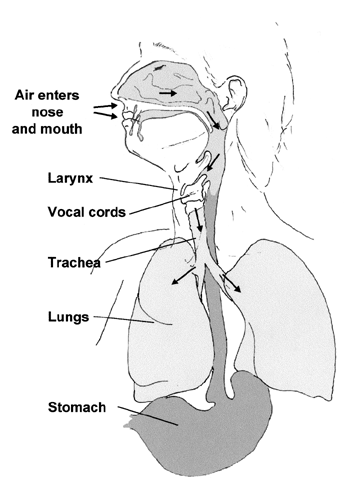
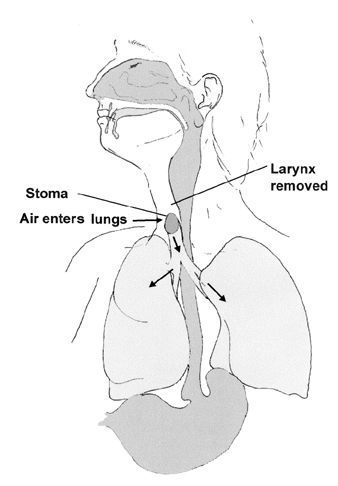
Some other changes you may experience after your laryngectomy are:
- Decreased ability to smell because you are unable to inhale odors through your nose.
- Decreased ability to taste because this is affected by odors and ability to smell.
- Inability to blow your nose because you cannot exhale air through your nose.
- Inability to hold your breath and bear down.
- Inability to warm, moisten, or filter the air you inhale.
COMMUNICATION--SPEECH
A speech pathologist will talk with you about other methods of speaking. You may need to write messages until you learn a different means of speaking.
HAND WASHING/CLEAN SUPPLIES
Because your hands may spread germs, you must wash your hands before and after all cares. Clean supplies must be used.
HUMIDITY
Extra humidity is required because the nose and mouth, which filter, warm, and moisten the air you breathe, are bypassed. The amount of moisture needed will vary. Use an ultrasonic nebulizer, or a room-size or cool-mist humidifier in your home. Drinking plenty of fluids also helps to keep your airway moist. Increased humidity will be needed during the winter months when your home becomes dry. More moisture is needed whenever secretions become thick, dry, or form mucous plugs (dry, crusted secretions). Pink or blood-tinged secretions may also indicate a lack of moisture. Putting (instilling) saline solution (a salt solution) into the trachea adds moisture and causes a cough to clear secretions from your airway.
CLEANING THE HUMIDIFIER
Germs will grow in a humidifier. Clean the unit to decrease the chance of respiratory infections. Refer to humidifier package insert for cleaning guidelines. Options for daily and weekly cleaning are listed below:
Daily
- Empty and clean tub with hot, soapy water. Rinse well.
- Fill with fresh tap water.
- Never add water to the humidifier without emptying and rinsing the tub.
Weekly
- Empty and rinse.
- Fill the humidifier tub with equal parts of vinegar and water and turn the humidifier on for 1 hour. Due to the strong smell of the vinegar, place the humidifier in a room where no one is present.
- Empty the humidifier and wash all parts with hot, soapy water. Rinse well.
- Fill the tub with clean water and turn on the humidifier for another hour.
- Empty and air dry. Unit is ready for use.
MAKING SALINE SOLUTION
Saline solution is a salt solution that can be made by boiling water for 5 minutes, then adding 1 1/2 level teaspoons of noniodized salt per quart of water. Cool to room temperature prior to use. Because germs may grow in the solution, discard unused saline solution after 24 hours.
INSTILLING SALINE SOLUTION
The purpose of instilling saline solution into your airway is to stimulate a cough and clear secretions.
- Pour small amount of saline solution into a clean cup.
- Draw up 2 to 3 cc into the syringe.
- While taking a deep breath, instill saline solution into your stoma.
- Cough while covering your stoma with a gauze sponge or soft paper towel.
- Repeat until your airway is clear. If unable to clear your airway with saline solution, use suction.
- Wash saline solution cups and syringes daily with hot soapy water, rinse thoroughly; air dry.
- When secretions become thick and dry, saline solution may need to be instilled as often as every hour.
SUCTION
The purpose of suction is to remove secretions that you cannot cough out. Suction will clear your airway and help you breathe easier.
- Connect suction catheter to tubing from suction machine.
- Moisten catheter tip with saline solution.
- Take 4 to 5 deep breaths.
- Gently insert the catheter through the stoma. Do not cover the suction control vent while you insert the catheter. Pass the catheter as far as you can without force, then withdraw slightly before starting suction (see Figure V.D.1.3).
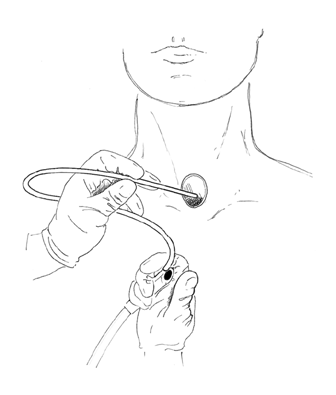

- Suction saline solution to clean the catheter.
- Do not insert the catheter more than 3 times during a suctioning period. Take a few deep breaths between each time the suction catheter is inserted. If more suctioning is needed, allow yourself a 5- or 10-minute rest.
- Breathe deeply after the catheter is removed.
In most cases the use of saline solution and a humidifier keeps your secretions thin enough to cough or suction out. If you have thick secretions, mucous plugs, or a feeling that your airway is not clear, the following may help:
- Fill the bathtub with hot water and sit in the steam-filled bathroom for 20 minutes.
- Place a moist all-gauze square over your stoma. Keep gauze damp. The gauze may be held in place by folding it over twill tape or bias tape and tied around your neck.
- Stand in the shower with the water directed away from your stoma.
- Fill a spray bottle with saline solution and spray into your stoma several times a day.
CLEANING SUCTION CATHETERS
- Place catheters under cool running tap water to rinse secretions.
- Wash catheters well in hot, soapy water (mild liquid soap) and rinse with tap water. It may be helpful to attach the catheter to suction to remove any remaining soapy water.
- Soak catheters in equal parts of white vinegar and tap water (1 cup vinegar to 1 cup water) for 1 hour. Rinse catheters with saline solution. Connect catheter to suction to rinse inside of each catheter.
- Air dry catheters on a clean towel.
- Store catheters in a clean, covered container.
SUCTION MACHINE CARE
- Empty suction bottle into the toilet.
- Wash the suction bottle and tubing daily with hot, soapy water.
AIRWAY CARE
Cleaning
The skin around your stoma should be kept clean and dry. Cotton-tipped applicators (eg, Q-tips or a damp washcloth) may be used to gently remove secretions surrounding the stoma. It may help to apply a thin film of petrolatum ointment to the outer edges of your stoma to prevent crusting.
Covering
Cover your stoma to prevent dust, insects, or other foreign matter from entering your stoma and to moisten and warm the air you inhale. The covering will also decrease the sound of breathing from your stoma and stoma odors. Cover your stoma with an all-gauze square folded over twill tape or bias tape tied around your neck (see Figure V.D.1.5). A variety of stoma shields or covers are available. If you are interested, ask your nurse or speech pathologist for more information.
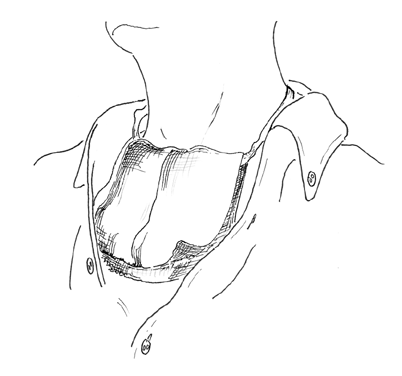
You may wish to use a different style of stoma cover. Women may like to use a scarf, high-necked dress, or a turtleneck sweater. For men, a high neck T-shirt, turtleneck, or dress shirt with an ascot may be worn.
Appliances
Your stoma will remain open; therefore, you may not need an appliance inserted into your stoma. Over a period of time, however, the stoma may slowly decrease in size. This is called stoma stenosis. The stoma size may be maintained by the periodic or continuous use of a stoma vent or a laryngectomy tube.
The stoma vent is a commonly used appliance (see Figures V.D.1.6 and V.D.1.7 below). Some people prefer to use the stoma vent at all times because it helps to keep the stoma edges clean and free of secretions. The correct size stoma vent will be selected for you.
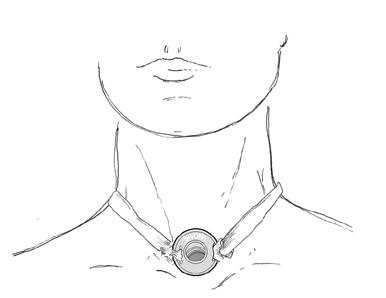
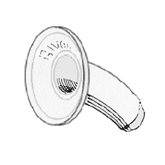
Stoma Vent
- Clean stoma.
- To secure vent in stoma, insert ties into openings in outside rim of the vent.
- Lubricate the vent with saline solution or a water soluble gel (K-Y Lubricant).
- Insert the vent and secure ties around the neck.
- Do not use petrolatum ointment on the stoma while using a stoma vent. The ointment may destroy the stoma vent.
- Clean the vent at least twice a day using a soft brush or pipe cleaners, mild soap, and water. Rinse well under running tap water.
- Do not use the vent if it is cracked, damaged, or if it does not fit your stoma. Consult your nurse or doctor when necessary.
- If you use a laryngectomy tube, instructions will be given regarding care, insertion, and cleaning.
PRECAUTIONS
- When bathing or showering, keep water out of your stoma. Do not swim.
- Avoid powders, aerosol sprays, dust, smoke, and lint from facial tissues. Do not smoke.
- Do not use facial tissues to cover your stoma because they may shred.
- Do not use over-the-counter antihistamines (cold medications), which dry secretions and the airway.
EMERGENCY INFORMATION
- Talking on the telephone may be difficult. Plan a way to get help in case of an emergency. Place emergency numbers near the phone, such as the fire department, ambulance, visiting nurse, or doctor.
- During cardiopulmonary resuscitation (CPR), breathing must be performed mouth to stoma, not mouth to mouth.
- Oxygen administration must be through the stoma, not the nose or mouth.
- A medical alert bracelet/necklace (see Figure V.D.1.8 below) from a drug store pharmacy should be worn. Information can be etched on the back of the bracelet/necklace to inform others that you breathe through a stoma in your neck.
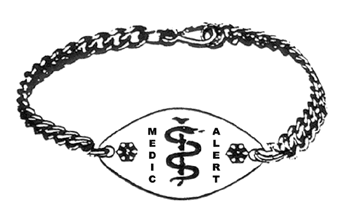
ACTIVITY
Unless there are other limiting conditions, you should be able to continue your usual activities other than those such as swimming or boating. It may not be necessary to change occupations unless the environment in which you work is very dusty or there are extreme temperatures, as you will find breathing in these conditions uncomfortable.
MOUTH CARE
Because of your decreased ability to taste and smell, you will not be aware of mouth odors. Daily oral hygiene should be performed.
DIET
Unless you have had additional surgery or radiation therapy, your ability to eat and swallow should not be affected by your laryngectomy. If you have difficulty swallowing or eating, contact your physician. Because you are unable to hold your breath and bear down, constipation may be a problem. Include high-fiber foods (fresh fruits and vegetables, bran, whole grain bread, and cereals) in your daily diet to facilitate normal bowel movements. Exercise and increased amounts of liquids will also help. Use an over-the-counter laxative if needed.
DISCHARGE INFORMATION
Before you leave the hospital, a visiting nurse may be contacted to assist you with your home care and help you obtain supplies. Supplies may be obtained from a drug store or medical supply company. Arrangements for a suction machine, if needed, will be completed before you leave the hospital. Most patients rent the suction machine. The need to suction may decrease over time. Return the suction machine when it is no longer needed. Arrange to have a humidifier at home.
The International Association of Laryngectomees (IAL) is an organization designed to benefit you and your family. It is sponsored by the American Cancer Society and is composed of many local chapters called "Lost Chord Clubs." For additional information contact:
American Cancer Society--Iowa Division
8364 Hickman Road
Des Moines, IA 50322
Phone: 1-800/227-2345
HOME SUPPLIES
The following will be sent home with you:
- Sterile saline solution
- 5 cc syringes for instilling saline solution (a medicine dropper may also be used)
- Small containers with lids for saline solution
- Gauze squares to use when coughing (soft paper towels may be used instead)
- Suction catheters
- Connecting tubing for suction machine (if not supplied by medical equipment company)
- Cotton-tipped applicators (extra long)
- Plastic basin
- Stoma vent if ordered
- Brush/pipe cleaners
- Velcro straps or twill tape
WARNING SIGNS
Please notify your physician if you feel you are having problems or if any of the following occur:
- Difficulty breathing or noisy breathing that sounds obstructed
- Dry, crusted secretions (mucous plugs) or blood-tinged secretions from stoma
- Chest discomfort
- Increased tracheal secretions
- Thick, foul-smelling secretions
- Fever
- Decrease in stoma size or inability to insert stoma vent
- Redness or skin breakdown around stoma
- Difficulty swallowing or eating
- Separation of the incision, drainage or increased swelling